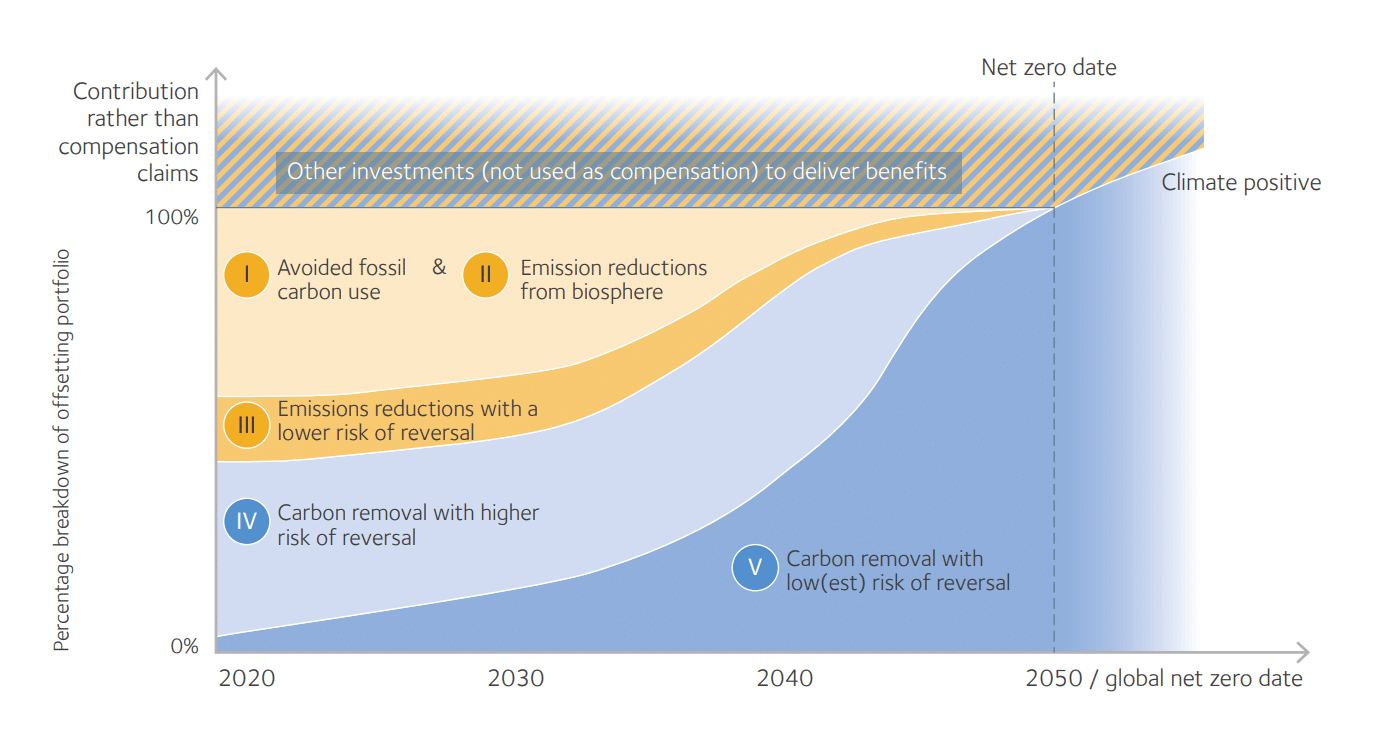
Companies with Science-Based Targets initiative (SBTi) net-zero targets are increasingly turning to using carbon credits in the pursuit of becoming global climate action leaders. Carbon credits serve as a key mitigation strategy for taking environmental responsibility for corporate unabated Greenhouse Gas (GHG) emissions. However, to ensure that these efforts contribute meaningfully to climate action, they should align with robust principles and guidelines, such as the revised Oxford Offsetting Principles (Axelsson et al., 2024), SBTi’s Beyond Value Chain Mitigation (BVCM) strategies, and the updated Voluntary Carbon Market Integrity (VCMI) Claims Code of Practice. Callirius supports such alignment and divulges it on the proprietary Callirius Quality Framework (CQF) used to assess the quality and integrity of carbon projects. In this article, we delve into the standards, tools and approaches that enable effective, high-integrity corporate carbon credit strategy and execution.
1. Embracing the Oxford Offsetting Principles
The Oxford Offsetting Principles for Net-Zero Aligned Carbon Offsetting, revised earlier this 2024, set a high bar for carbon offsetting activities. These principles demand using offsets responsibly and as part of a broader strategy that first tackles a company’s own emissions reduction efforts, rather than as a primary “outsourced” solution. It builds upon four principles:
- Cut emissions and ensure the environmental integrity of credits used to achieve net zero, and regularly revise your offsetting strategy as best practice evolves
- Transition to carbon removal offsetting for any residual emissions by the global net zero target date
- Shift to removals with durable storage (low risk of reversal) to compensate for any residual emissions by the net zero target date
Support the development of innovative and integrated approaches to achieving net zero

2. Activating Beyond Value Chain Mitigation (BVCM): a gateway to net zero
The recently launched reports from SBTi i.e., “Above and Beyond: Report on BVCM“ and “Raising the Bar: Report on BVCM” provide comprehensive guidance on implementing BVCM strategies after achieving net zero. These reports underscore the importance of going beyond immediate operational boundaries and contributing to wider climate action through initiatives such as funding renewable energy projects, supporting reforestation, or investing in carbon capture technologies. This approach not only aids in achieving net-zero targets but also fosters sustainable development globally. The BVCM goals and principles below have been developed to guide companies on how to move towards high-impact and high-integrity BVCM activities and investments:
- Goal 1: deliver additional near-term mitigation outcomes to achieve the peaking of global emissions in the mid-2020s and the halving of global emissions by 2030.
- Goal 2: drive additional finance into the scale-up of nascent climate solutions and enable activities to unlock the systemic transformation needed to achieve net zero by mid-century globally.
BVCM portfolio design principles are based on 4 actions:
- scaling mitigation outcomes,
- focus on underfinanced mitigation activities,
- support the Sustainable Development Goals (SDGs) and
- address inequalities in climate mitigation activities
3. Making credible claims with the VCMI Claims Code of Practice
The updated VCMI Claims Code of Practice, released in late 2023, offers a concrete framework for companies to make credible claims about using carbon credits. This code ensures that carbon credits are used as part of a genuine effort towards carbon neutrality, without replacing direct action to reduce emissions.

A particularly notable aspect is the introduction of the ‘Scope 3 Flexibility Claim’, which allows companies to responsibly handle their indirect emissions through high-quality carbon credits. This claim, set to be finalized in 2024, is designed to incentivize companies to act immediately against climate change while progressively enhancing their internal decarbonization efforts.
4. Conducting effective due diligence using the Callirius Quality Framework (CQF)
The CQF is a science-backed, data-driven framework ensuring the integrity, effectiveness, and positive impact of carbon projects on climate, nature, and society. It emphasizes nature-based carbon projects with co-benefits, supporting robust approaches to ensure effective, credible, and trustworthy carbon credits. Key features of the CQF include:
- Continuous monitoring and digital Measurement, Reporting and Verification (dMRV), ensuring the ongoing success and reliability of carbon projects
- Alignment with leading standards, initiatives and frameworks in the VCM: Incorporating principles from VCMI, the Oxford Offsetting Principles, and ICVCM-CCP, among others
- Support for BVCM, enabling investments in mitigation activities beyond direct operations
The CQF considers the widely recognised policies and guidelines detailed above in the assessment of carbon projects as a way to ensure that these initiatives contribute meaningfully to climate action, both from a project developer and financier perspective.
5. Zoom-in: Callirius’ approach to carbon credit portfolio building and management
At Callirius, we advocate for a strategic and comprehensive approach to building and managing a portfolio for carbon offsetting and BVCM action, we encourage companies to:
- Align with science-based targets, targeting milestones like carbon neutrality in energy-related emissions by 2025 and achieving net-zero carbon emissions across all scopes by 2040, in line with Science-Based Targets initiative (SBTi) guidelines.
- Focus on long-term carbon credit procurement, emphasizing the importance of long-term planning and a robust strategy to secure a substantial volume of carbon credits by 2040 and beyond.
- Create a diverse carbon project portfolio, incorporating a blend of nature-based reductions and removals, including initiatives like afforestation, regenerative agriculture, and biochar. This diversity is key for risk management and ensuring a high, meaningful environmental impact.
- Ensure global and local impact, selecting carbon projects that align with global corporate strategies while also delivering tangible local environmental and social benefits.
- Prioritize co-benefits and compliance, by investing in projects that show verified sustainability impacts and adhere to reputed standards for meeting net-zero targets. Additionally, for BVCM targets, we suggest sponsoring projects which are either certified or non-certified but have proven environmental and social impact using an dMRV framework. In both cases, the projects should contribute to various SDGs, ensuring a holistic approach to corporate sustainability.
- Adopt a tailored and adaptable strategy, including a gradual increase in the share of SBTi-aligned removal credits, reaching 100% by 2040. This reflects an adaptable approach, capable of evolving with changing standards and emerging needs in the realm of carbon offsetting.

6. Integrating these approaches for designing robust corporate climate action strategies
A corporate climate strategy shall be supported by a science-based climate action and decarbonization pathway that aligns with the Paris 1.5°C goal. Unabated emissions are gradually reduced over the years and simultaneously complemented with BVCM engagement until net zero is reached. At that point, residual emissions shall be unendingly neutralized by financing effective carbon-negative initiatives proportionally. Going one step further, historical emissions shall also be considered for neutralization.

For corporate customers targeting SBTi net-zero goals, integrating the Oxford Offsetting Principles, BVCM strategies, and the VCMI Claims Code of Practice offers a comprehensive, effective and credible approach to climate action. A corporate climate strategy entails a circular process of continued review. This helps ensure it aligns with the latest scientific evidence and guidance while fostering sustainable business operations and integration with the company’s mission.

To sum up, this article serves as the foundational piece for our forthcoming comprehensive guide, detailing a 10-step approach to formulating best practices in crafting a science-aligned climate action strategy. It focuses on the pivotal role of carbon credits and the nuances of managing a carbon credit portfolio effectively. Our objective is to equip companies with the knowledge and tools necessary to navigate the complexities of climate strategy development, ensuring their actions are impactful, grounded in the latest scientific principles, and supported by various frameworks and initiatives in the global carbon market.
Are you planning to build a future-proof climate action strategy supported by the use of carbon credits? Let’s talk or schedule a demo with our experts.
References:
- Axelsson, K., Wagner, A., Johnstone, I., Allen, M., Caldecott, B., Eyre, N., Fankhauser, S., Hale, T., Hepburn, C., Hickey, C., Khosla, R., Lezak, S., Mitchell-Larson, E., Malhi, Y., Seddon, N., Smith, A. and Smith, S.M. 2024. Oxford Principles for Net Zero Aligned Carbon Offsetting (revised 2024). Oxford: Smith School of Enterprise and the Environment, University of Oxford. https://www.smithschool.ox.ac.uk/sites/default/files/2024-02/Oxford-Principles-for-Net-Zero-Aligned-Carbon-Offsetting-revised-2024.pdf
- Raising the Bar: An SBTi Report on Accelerating Corporate Adoption of BVCM, SBTi, v1.0, 2024.
- Above and Beyond: An SBTi Report on the Design and Implementation of BVCM, SBTi, v1.0, 2024
- VCMI Claims Code of Practice, building integrity in voluntary carbon markets, November, 2023. V.2.
- VCMI Scope 3 Flexibility Claim, Beta version
- Balderas, A., Luna, E., Voora, V., & Larrea, C. (2024). Voluntary standards and initiatives for carbon management: Navigating the landscape. International Institute for Sustainable Development. https://www.iisd.org/system/files/2024-01/voluntary-standards-initiatives-carbon-management.pdf
- Natural Climate Solutions and the Voluntary Carbon Market: A Guide for C-suite Executives, WBCSD, 2022.
- Callirius Quality Framework (CQF), Callirius AG, 2023.




